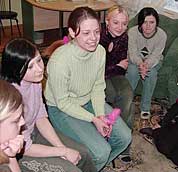|
|
| |
 |
| |
| An HIV/AIDS prevention seminar attended by a group of Russian orphans. |
|
According to UNAIDS, the number of people officially registered with HIV/AIDS in the Russian Federation has increased almost 100-fold in just eight years. By the end of 2004, the Russian Federation had cumulatively registered 298 391 HIV cases, 1357 AIDS cases and 985 AIDS deaths. In the year 2004, Russian authorities reported 34 288 new HIV cases, 214 new AIDS cases and 165 AIDS deaths. According to a recent report by Murray Feshbach and Cristina Galvin of the Woodrow Wilson Center in Washington underwritten by the U.S. Agency for International Development, the real numbers are at least three times greater.
The Feshbach Gavin report, which compared Russian and international statistics, found that the HIV/AIDS epidemic in Russia differs significantly from the disease in North America and Western Europe in terms of age. "In the West, broadly speaking, some 70 percent of the population afflicted with this illness are . . . over 30 years of age: In Russia . . . over 80 percent are under 30 years of age." The march of the disease through Russia's young is vividly illustrated in the number of potential army conscripts who test positive for HIV. In the last five years, the number testing positive has increased 25 to 27 times.
Due to weaknesses in the health information systems used, there is also a considerable delay in reporting HIV/AIDS data. As a result, authorities in Russia have no information on the mode of transmission but the Federal HIV/AIDS Center acknowledges that women account for an increasing share of newly diagnosed HIV infections—33% in 2002, compared to 24% a year earlier. According to UNICEF, approximately 40% of all newly registered cases of HIV were women 20-29 years old. This indicates the onset of a new stage in the epidemic in parts of the country, where the heterosexual spread of the virus is becoming a more prominent feature as the disease moves into the general population making it imperative that Russian secondary schools begin teaching an effective HIV/AIDS prevention curriculum which has the support of parents and regional Departments of Education.
In spite of mounting evidence of the HIV/AIDS pandemic and growing heterosexual transmission among youth, the Ministry of Education has been slow to respond to the urgent need for education of Russian teens. Much of this is a result of the legacy of the Soviet system but there are other pressures including the powerful censorship of the Russian Orthodox Church of most proposed curricula. According to the Ministry, over 800 curricula were submitted to the Ministry of Education seeking approval for use in schools during the past five years. Most were ignored or rejected.
We have subsequently developed a comprehensive program to address all that is required in order to put HIV/AIDS education into classrooms reaching 80% of teens in 9 key population centers which represent 28.4% of the population of Russian secondary school students within three years with comprehensive preventive education.
|
| Board games and other multimedia materials are used in HIV/AIDS eduation. |
In 2005, MiraMed was invited to work within the Ministry of Education to review curriculum materials and to write a curriculum acceptable to the Ministry, the Department of Education of Moscow, a panel of teachers, psychologists and social workers and representatives of the Russian Orthodox Church.
The result is the award winning NAVIGATOR curriculum which was chosen as the best program by the Moscow Department of Education from 32 Moscow finalists and is now piloting in Moscow schools.
Specific lesson topics include HIV/AID and STD infection information as well as units on moral values and societal norms, decision-making and self-confidence, and media manipulation. Information on contraception is presented at the secondary level but an emphasis for prevention is on abstinence and fidelity in marriage and responsibility in relationships.
|
|
